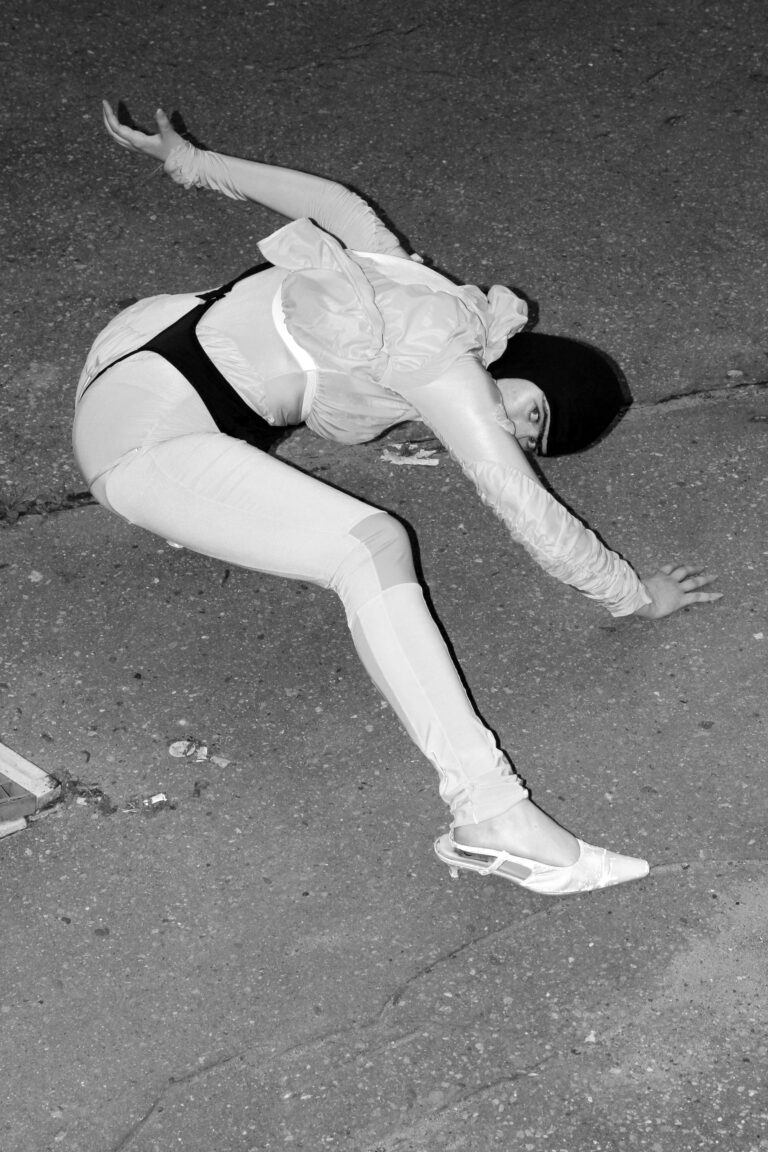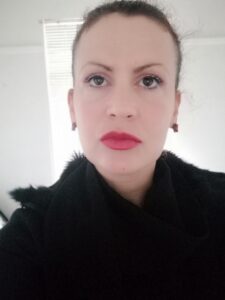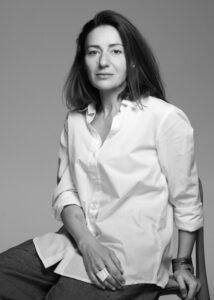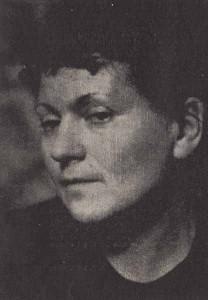Bożna Wydrowska

– born in 1994. Graduate of the Faculty of Media Art at the Warsaw Academy of Fine Arts. A visual artist, dancer, choreographer and performer working in the field of experimental and alternative choreographic practices of movement and voice. She lives and works in Warsaw.
For me, art is an inseparable part of life. It gives me the opportunity to transform reality and create new identities. I understand my own identity as something that is constantly changing, fluid and unstable. Another important influence on my work is the feeling of inadequacy that has always accompanied me. I think this made me search for new worlds and made me interested in otherness as such.
I don’t fully identify with my body – I treat it a bit like a separate entity. Sometimes I don’t feel my body at all, and sometimes it’s a huge burden for me. In my works I experiment with different images, I transform my body with costumes and make-up1. Thanks to this, I can hide something and reveal it at the same time. I can become my own fantasy and the fantasy of others.
My gender identity is also fluid and changeable2. I used to want to feel more like a man, but for a long time I thought of myself outside of all gender categories. Today I am interested in the power of a strong femininity, which we can actually find in ourselves regardless of our gender. The same goes for my sexual orientation, which I cannot clearly define – maybe I don’t have one at all? This indeterminacy has its good and bad sides, but it still gives me the strength to fight against culturally imposed social roles and behaviours.
The themes of identity and being in the body are explored in my performative work I am going to use this body to become you. During the performance I try to become the viewer who looks at me. Through eye contact I draw on everything that his presence gives me. It may be a movement, a stillness, a gesture, an emotion or a certain way of being. I look for understanding – I imagine what it is like to be in his body, to read his thoughts. I also try to guess his expectations of my behaviour. I want our meeting, even for this short moment, to be sincere and intimate.
I want my work to be inclusive. I believe that the relationship between the artist and the viewer should work on the basis of mutual exchange. This is also what my performance is about – the courage to wander, and discovering new identities together. About the fact that who we are and what we have is not only ours, but we got it by communing with others.
I started exploring the theme of fluid identity by attending ballrooms. Ballroom culture has been present in my life since 2012. Initially there was an interest in Vogue dance. I was very intrigued by the history of the ballroom and the fact that it was created by non-heteronormative people. I find it fascinating that the ballroom functions as an alternative world with its own structure and rules3. Ballroom has given me a new family, a new identity, and the tools to create those next.
By developing ballroom culture in Poland, I want to create a space not only for people interested in dance, performance, choreography and music, but above all for those who feel excluded. Ballroom has shaped my perception of the world, helped me open up to other areas of art, get to know new cultures. I believe that its inclusive nature helps to build a sense of community between people from different backgrounds in a spirit of empathy and tolerance4.
Socio-political issues have a great influence on my life and work. In the current political situation, it would be difficult for me to create art that does not refer to them at all. What is important for me in art is empathy, solidarity, nurturing relationships, fighting against violent patterns and hierarchies ingrained in culture. I believe that dance, choreography and performance have a huge culture-creating potential. Not only our voice, but also our body in motion is an important tool to fight against social and political oppression.
The text was written in collaboration with Maja Demska (2021).
1Image: Bożna Wydrowska, Sensualization, 2020, exhibition, Piktogram, Warsaw. Courtesy of the artist and Piktogram Gallery.2Image: Bożna Wydrowska, Un mélange d'emotions mitigés, 2021, performance, exhibition „Ménage á Deux”, Labirynt Gallery, Lublin. Courtesy of the artist and Labirynt Gallery.
3Image: Bożna Wydrowska, Sir Thaddeus, 2019, Ball at Bożena's #8, Warsaw. Courtesy of the artist.
4Image: Bożna Wydrowska, We Are Human, 2020, exhibition, Labirynt Gallery, Lublin. Courtesy of the artist and Labirynt Gallery.
– urodzona w 1994. Absolwentka Wydziału Sztuki Mediów warszawskiej Akademii Sztuk Pięknych. Artystka wizualna, tancerka, choreografka oraz performerka działająca na polu eksperymentalnych i alternatywnych praktyk choreograficznych ruchu i głosu. Mieszka i pracuje w Warszawie.
Sztuka jest dla mnie nieodłączną częścią życia. Daje mi możliwość transformowania rzeczywistości i tworzenia nowych tożsamości. Własną tożsamość rozumiem jako coś co cały czas się zmienia, jest płynne, niestałe. Istotny wpływ na moją twórczość ma także poczucie niedopasowania, które od zawsze mi towarzyszy. Myślę, że to skłoniło mnie do poszukiwania nowych światów i sprawiło, że zainteresowałam się innością jako taką.
Nie utożsamiam się w pełni ze swoim ciałem – traktuje je trochę jak osobny byt. Czasami w ogóle nie czuję swojego ciała, a czasami jest ono dla mnie wielkim ciężarem. W swoich pracach eksperymentuję z różnymi wizerunkami, transformuję swoje ciało za pomocą kostiumów i makijażu1. Dzięki temu mogę coś ukryć i jednocześnie odsłonić. Mogę stać się swoją własną fantazją oraz fantazją innych.
Moja tożsamość płciowa jest również płynna i zmienna2. Kiedyś chciałam czuć się bardziej jak mężczyzna, ale przez dłuższy czas myślałam o sobie poza wszelkimi kategoriami genderowymi. Dziś interesuje mnie moc silnej kobiecości, którą tak naprawdę możemy odnaleźć w sobie bez względu na naszą płeć. Podobnie wygląda kwestia mojej orientacji seksualnej, której nie mogę jednoznacznie określić – może nie mam jej w ogóle? To nieokreślanie się ma swoje dobre i złe strony, ale mimo wszystko sprawia, że mam siłę do walki z narzuconymi kulturowo rolami społecznymi i przypisanymi im zachowaniami.
Tematy tożsamości i bycia w ciele poruszam w pracy performatywnej I am going to use this body to become you. W czasie performansu usiłuję stać się odbiorcą, który na mnie patrzy. Poprzez kontakt wzrokowy czerpię ze wszystkiego co daje mi jego obecność. Może być to ruch, bezruch, gest, jakaś emocja, czy pewien sposób bycia. Szukam porozumienia – wyobrażam sobie jak to jest być w jego ciele, czytać w jego myślach. Próbuję też odgadnąć jego oczekiwania względem mojego zachowania. Zależy mi na tym, żeby nasze spotkanie, nawet przez tę krótką chwilę, było szczere i intymne.
Chcę, żeby moje prace były inkluzywne. Sądzę, że relacja między artystą a odbiorcą powinna działać na zasadzie wzajemnej wymiany. O tym też jest mój performans – o odwadze błądzenia, i o wspólnym odkrywaniu nowych tożsamości. O tym, że to jacy jesteśmy i co mamy, nie jest jedynie nasze, ale dostaliśmy to obcując z innymi.
Temat płynnej tożsamości zaczęłam eksplorować biorąc udział w balach. Kultura ballroom jest obecna w moim życiu od 2012 roku. Na początku było zainteresowanie tańcem Vogue. Bardzo intrygowała mnie historia ballroomu oraz fakt, że została stworzona przez osoby nieheteronormatywne. Fascynuje mnie to, że ballroom funkcjonuje jako alternatywny świat o własnej strukturze i zasadach3. Ballroom dał mi nową rodzinę, nową tożsamość, i narzędzia do tworzenia tych kolejnych.
Rozwijając kulturę ballroom w Polsce, chcę stworzyć przestrzeń nie tylko dla osób zainteresowanych tańcem, performansem, choreografią i muzyką, ale przede wszystkim dla osób, które czują się wykluczone. Ballroom ukształtował moje postrzeganie świata, pomógł mi otworzyć się na inne dziedziny sztuki, poznać nowe kultury. Wierzę, że jego inkluzywny charakter pomaga budować poczucie wspólnoty pomiędzy ludźmi z różnych środowisk w duchu empatii i tolerancji4.
Kwestie społeczno-polityczne mają duży wpływ na moje życie i twórczość. W obecnej sytuacji politycznej trudno byłoby mi tworzyć sztukę, która zupełnie się do nich nie odnosi. W sztuce ważne są dla mnie empatia, solidarność, pielęgnowanie relacji, zwalczanie zakorzenionych w kulturze przemocowych schematów i hierarchii. Uważam, że taniec, choreografia i performans mają ogromny potencjał kulturotwórczy. Nie tylko nasz głos, ale też nasze ciało w ruchu jest ważnym narzędziem walki ze społeczną i polityczną opresją.
Tekst powstał we współpracy z Mają Demską (2021).
1Zdjęcie: Bożna Wydrowska, Sensualization, 2020, wystawa, Piktogram, Warszawa. Dzięki uprzejmości artystki i Galerii Piktogram.2Zdjęcie: Bożna Wydrowska, Un mélange d'emotions mitigés, 2021, performans, wystawa „Ménage á Deux”, Galeria Labirynt, Lublin. Dzięki uprzejmości artystki i Galerii Labirynt.
3Zdjęcie: Bożna Wydrowska, Sir Thaddeus, 2019, Bal u Bożeny #8, Warszawa. Dzięki uprzejmości artystki.
4Zdjęcie: Bożna Wydrowska, Jesteśmy ludźmi, 2020, wystawa, Galeria Labirynt, Lublin. Dzięki uprzejmości artystki i Galerii Labirynt.



